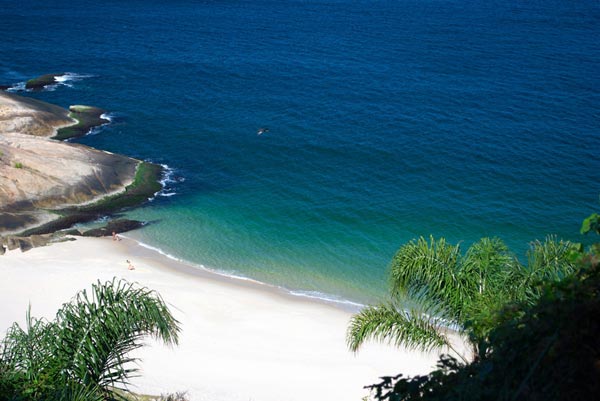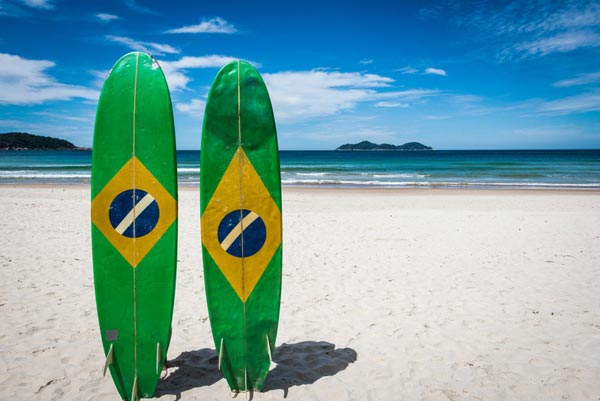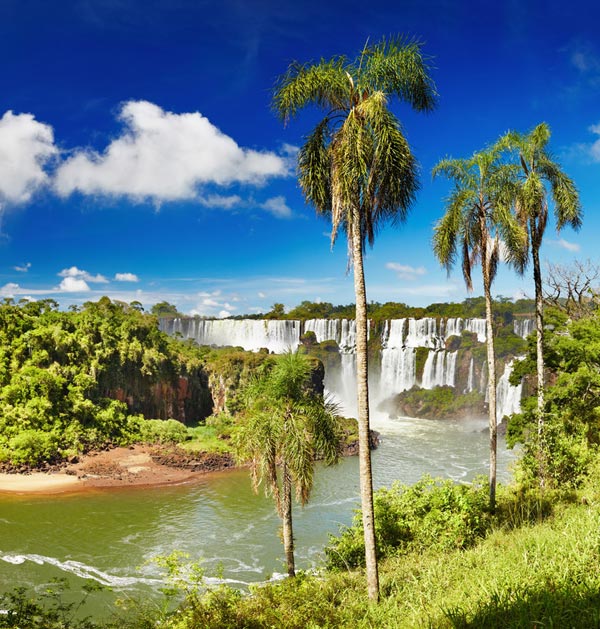From the heat of Rio’s nightlife to the chilled out atmosphere of Ilha Grande, discover the treasures of Brazil on this comfortable week long adventure vacation.
You’ll wander the colonial streets of Paraty—it’s a UNESCO heritage site and quite possibly the prettiest spot on the planet—and savour seafood and life without cars on the island of Ilha Grande.
Stand in awe of awesome Iguassu Falls deep in the interior, then marvel at it from Argentina’s side.
Your adventure vacation in Brazil awaits—let’s make the most of it.
Itinerary for your Adventure Vacation in Brazil
Day 1 Rio de Janeiro
On arrival in Rio, an airport transfer is included to bring you to the hotel. There are no planned activities, so check into to centrally-located hotel in Copacabana (check-in time is approx 3pm) and enjoy the city. In the evening (approx 7pm) you will meet your Chief Experience Officer (CEO) and fellow group members to go over the details of your trip. Check the notice board (or ask reception) to see the exact time and location of this group meeting. After the meeting we will be heading out for a meal in a nearby local restaurant (optional). If you arrive late, no worries, the CEO will leave you a message at the front desk.
“God made the world in six days, the seventh he devoted to Rio,” so say the Cariocas, residents of this beautiful city. This is a densely packed metropolis of over 9 million inhabitants, whose economic foundations lie in the cultivation of sugar cane and gold mining. Referred to as the “Cidade Maravilhosa” (Marvellous City), few cities enjoy such a dramatic setting as Rio. Brilliant, white beaches in Copacabana and Ipanema, the deep blue waters of the Atlantic, the luminescent green of Guanabara Bay, and the bare blue slopes of the Sugar Loaf combine to make Rio unique. Standing over it all, at the topo of Corcovado mountain, is the huge statue of Christ the Redeemer; the best place to appreciate the city. Superb panoramic views of the city and area can also be found from the top of the Pao de Açucar -Sugar Loaf – reached by cable car. Head to some of the famous beaches, and prepare yourself for an experience unlike anything else on Earth.
Although the Portuguese first sailed and entered the bay, it was the French who first established a settlement in the area, logging Brazilian wood along the coast. Their first permanent settlement lasted a brief five years, when they were attacked and driven from the area by the encroaching Portuguese. A series of skirmishes ensued, with the Tomaio people allied with the French against the Portuguese.
In 1567, the Portuguese began the construction of a fortified town to repel invaders, naming it Sao Sebastiao do Rio de Janeiro. With the amassing wealth of the gold rush of Minas Gerais, in the early 18th Century, Rio became Brazil’s most important city and a great temptation to the French who, in 1710, waged war against the Portuguese and held the city for a sizeable gold ransom. In the 19th century, the last members of the Portuguese monarchy fled to Brazil under the threat of Napoleon’s invasion. Many of today’s older structures of the city date from this period.
The gold rush was followed by a coffee boom in the mid-1800s, and the wealth generated led to the city’s initial modernization. Replacing Salvador de Bahia as the colonial capital in 1763, Rio remained the capital until 1960, when it was replaced by Brasilia. Today, the city is a magnet for tourists who come to walk along the beaches of Ipanema and Copacabana, and generally partake in the Carioca zest for life. Many ascend the Sugarloaf Mountain (Pao de Açucar), whose image is nearly synonymous with Rio and Carnival. Modern Rio is, perhaps, best known for the contrasting images offered by the favelas (shanty towns), and the glitz and glamour preferred by the Samba schools and their Carnival celebrations.
Rio is definitely a tale of two cities: the city is divided into a Zona Norte (North Zone) and a Zona Sul (South Zone) by the Serra da Carioca, steep mountains that are part of the Parque Nacional da Tijuca. These mountains descend to the edge of the city centre, where the two zones meet. The upper and middle classes reside in the Zona Sul, the lower class in the Zona Norte. Favelas cover steep hillsides on both sides of town – Rocinha, Brazil’s largest favela, is in Sao Conrado, one of Rio’s richest neighbourhoods. Most industry is in the Zona Norte, as is most of the pollution. The ocean and beaches are in the Zona Sul.
Day 2-3 Ilha Grande (2B)
From Rio head south along the Atlantic coast by private vehicle to one of the picturesque, laid-back islands on the coast, llha Grande. Relax and walk the clean sand beaches or bathe in the warm waters of this island paradise. Options include hikes through the jungle to waterfalls, a nearby black sand beach, boats or hikes to other secluded beaches or just hanging out in the laid-back World Heritage town centre.
The local fauna and flora in Ilha Grande, a Nacional Patrimony protected area, are extremely diverse. The state park was created in 1971 and encompasses 4.500 hectares of wilderness. Mountain range, coastal, mangrove and prairie vegetation are all found here, along with an astonishing collection of bird life, including parrots, woodpeckers, Brazilian thrushes and saracuras. There are also different kinds of monkeys, squirrels, armadillos, pacas, hedgehogs and snakes, as well as endangered species such as the Alouatta Fusca, generally known as Bugio monkey.
Rio de Janeiro to Ilha Grande
Approximate distance:150km
Estimate travel time:4 hours (1 hour by ferry)
Day 4-5 Paraty (2B,2L)
Continue by ferry and van to the colonial city of Paraty and enjoy an included schooner tour of the harbour’s many islands and beaches. Also visit an Afro-Brazilian community for a unique cultural interaction and enjoy a traditional meal. Option to visit cachaça distillery.
This quaint, colonial town is an architectural gem famous for its churches. Located on Brazil’s Costa Verde or “Green Coast,” UNESCO World Heritage Paraty is known as much for the natural beauty of its surroundings as it is for its excellent cachaça. Explore the cobblestone streets and cafés of the historical centre of Paraty, and we include a schooner tour of the bay, visiting pristing nearby beaches and emerald waters.
125 miles from Rio de Janeiro, on the edge of picturesque Ilha Grande Bay, Paraty is a lovely colonial town. On the border between Rio de Janeiro and São Paulo states, it is a favourite with those looking to ‘get away from it all’—Brazilians and visitors alike. Considered one of the world’s most important examples of Portuguese colonial architecture by UNESCO, the historic centre is a well-preserved national historic monument, and today has been closed to vehicles to preserve its laid-back colonial ambience. During high tide, the Portuguese cobblestone streets are partly flooded by seawater, adding to the fairy tale atmosphere.
Located between the lush green mountains and the sea, Paraty (sometimes spelled Parati) was once a place of significant economic importance due to its sugar cane mills. At its peak the city was home to over 250 distilleries, and the name Paraty was synonymous with world-class sugar cane rum.
Founded in 1531, the original settlement was on the opposite side of the river, where a church was erected to their patron “St. Roque.” Around 1640, the Indians, who used to live here, were driven away and the town moved to where it stands now. The founders named it Nossa Senhora dos Remédios (Our Lady of the Medicines) as the patron saint and built the main church in her honour. Enlarged and remodelled over the years, the church is now the focal point of the annual Festa de Nossa Senhora dos Remédios on September 8. The festival has been celebrated for over 300 years since a wealthy and reverent benefactor, Maria Jácome de Mello, donated the land to the town for the church, requesting only an annual mass in return. The mass has grown into a procession of the wooden effigy of the Virgen though the town, adorned with gold and silver jewellery.
In the 1700s, when the mines of Minas Gerais were pouring out gold, the perfect bay of Paraty was a busy port, the second most important in Brazil during the ‘Golden Century.’ The best pinga or cachaça (sugar cane liquor) of Brazil was produced here and the name Paraty became synonymous with the liquor. Later, coffee was brought from the valley of Paraiba to be shipped to Portugal, sparking another economic boom. In 1888 with the abolition of the slavery, Paraty became almost forgotten in time, and a large exodus left only a population of around 600, a considerable difference from the 16 000 of the town’s prime. In 1954 a road was opened linking the town to the rest of the country through the valley of Paraiba, but it was not until 1973-75 with the opening of the highway BR-101 that Paraty’s rebirth as a tourist town began. It was declared a national monument in 1966.
Paraty’s bay is filled with over 65 tropical islands and dozens of beaches, each offering something different, and all covered with vegetation that remains lush and colourful year-round. The water of the bay is always the right temperature for swimming, diving and snorkelling. The national parks that encircle the town are filled with trails, wildlife and waterfalls.
Ilha Grande to Paraty
Approximate distance:100km
Estimate travel time:2.5 hours (1 hour by ferry)
Day 6-7 Iguassu Falls / Rio de Janiero (2B)
Travel by private van to Sao Paulo to catch the flight to Iguassu Falls.
Spend two days exploring the tri-border region where Brazil, Argentina and Paraguay meet at the junction of the Paraná and Iguazú rivers, with the focus on magnificent Foz do Iguaçu, or Iguassu falls. In order to see the falls properly you need to view them from both the Brazilian and the Argentinean side. The Brazilian side offers the grand overview, and the Argentinean side, a closer look. The best time of the year to see them is from August to November, as from May to July you may not be able to approach the swollen waters on the catwalks. We include a visit to both the Argentine and Brazilian side of the Falls. Experience an exhilarating optional boat tour at the falls or a trip to the bird sanctuary on the Brazilian side of the falls.
Note: If you have booked the Iguassu Falls Boat Ride Theme Pack, you will do it on Day 7 or 8 when visiting the Argentine side of the falls.
The torrential Iguassu River crosses the State of Paraná in Southern Brazil from East to West. A few kilometers before its junction with the Paraná River it forms one of the most splendorous natural beauties of the world: Iguassu Falls. Over 2.7 kilometres long and an average flow of 1.750 m3/s, this wonder is located in a very special place. The contrast between the green of the vegetation and the dark colour of the basalt rocks with whirring waters plunging from a 72-meter high cliff is magical. At Iguassu there are 275 falls in all, spread over a 3-km area, some over 80m (262.4 ft) in height, making these cataracts wider than Victoria Falls and higher than Niagara! It should come as no surprise that UNESCO declared the region a World Heritage Site in 1986.
Originally “discovered” in 1541 by the Spaniard Juan Alvar Nuñez, he named the falls Saltos de Santa María. The name we use today means “great waters” in the Tupi-Guarani tongue. The falls are protected by two National Parks—one in Brazil and another in Argentina. Tours utilize trails and catwalks adapted to the landscape of the area, and walking is easy for all ages; guided tours of the complex are available several times a day. In order to see the falls properly you need to view them from both the Brazilian and the Argentinean sides: the Brazilian side offers the grand overview, and the Argentinean side a closer look. The best time of the year to visit is from August to November, as during rainy season from May to July, flooding will likely prevent closer viewing from the catwalks.
Film buffs will remember that Iguassu was the site of several scenes from the film “The Mission.” Not far from the falls, the ruins of the Jesuit missions of the era can still be visited on a day trip. Also of interest in the area is Itaipú, the largest hydroelectric complex in the world. Experience an exhilarating optional boat tour or helicopter trip for a bird’s eye view, or simply marvel at nature’s breadth and the roar of the falls.
Day 8 Rio de Janeiro (1B)
Fly back to Rio and relax at our centrally-located hotel in Copacabana. Option to take in a Samba show.
Day 9 Rio de Janeiro (B)
Depart at any time.



